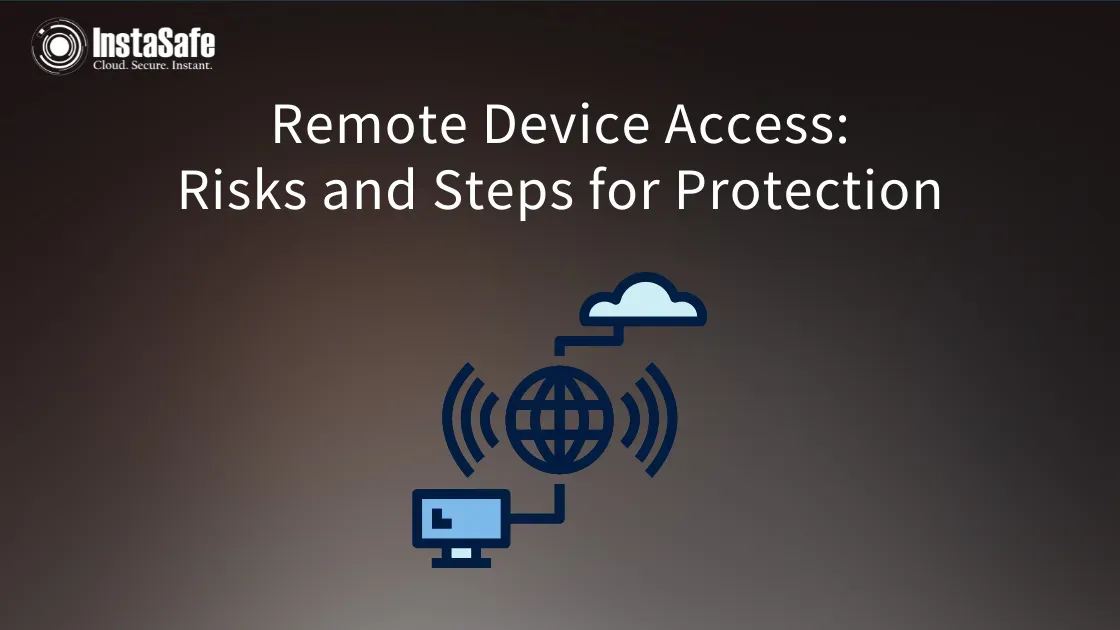Remote Device Access: Risks and Steps for Protection

Remote device access allows your remote employees and contractors to access the network resources through their own devices or company-owned devices and an internet connection.
During the global pandemic outbreak, the remote working environment and WFH situation accelerated in 2020, forcing companies to operate from remote locations. While it came with its own conveniences and allowed enterprises to save a lot of money, it also brought many cybersecurity and network security risks.
Hence, ensuring secure remote access for your employees to protect the network data and prevent potential breaches is highly important.
In this article, we’ll look at some of these major remote device access risks and how to combat them for network security. So, let’s dive right in!
Top Remote Device Access Security Risks and Solutions
Employees usually use public internet connections and insecure devices, which often put the company and its network security at risk.
Here are some of the major remote access device security risks and how you can prevent them.
Weak remote access policies
Most companies rely on perimeter-based network security solutions like Virtual Private Networks (VPNs) to enable remote access for employees. Unfortunately, these solutions provide implicit trust and assume the entire network traffic can be trusted once it enters the network perimeter—increasing security vulnerabilities and risks.
In addition, many legacy firewall-based rules with VPNs also enable access to every network resource and application.
Solution: Instead of providing access to the entire network resources, companies must implement access based on the user and device identity—providing access to specific data and applications. The best way to do this is by implementing Zero Trust Security.
Zero Trust Security maximises remote access security—removing the implicit trust, only allowing authenticated and authorised users to access the network, and providing access to specific resources, instead of the entire network.
Lack of remote user activity visibility
The lack of visibility of the user’s devices and lateral movement with remote access is another major security concern for businesses.
Many companies lack visibility into remote user activity, including the resources and applications that users try to access, so detecting advanced security threats from remote users and malicious entities becomes difficult.
Solution: Opting for security platforms that enable maximum and seamless integration between systems and tools is useful to reduce the amount of switching back and forth between these tools.
In addition, Zero Trust Network Access enables seamless integration and provides complete visibility across your network—including lateral movement and user activity.
Mixing personal and professional passwords
Employees lacking knowledge about password security often make the mistake of reusing passwords and setting the same personal and home passwords for accessing confidential data and applications.
This becomes a problem as hackers can easily guess passwords, hack into the systems, and remote access devices.
Solution: It’s important to educate employees about user and identity phishing attempts and password breaches—encouraging them to set a strong, powerful, complicated, and difficult-to-guess password to access the network and its resources.
In addition, it’s also important to implement Multi-Factor Authentication (MFA) and client certificates to make it difficult and prevent cyberattackers from accessing unsecured devices.
Phishing attempts
Phishing is still one of the most popular ways to access corporate networks and applications. It tricks remote employees into clicking on the malicious links—stealing their sensitive credentials.
Solution: Educating employees about identifying and reporting malicious or suspicious links and emails is the key to preventing them from falling into the trap of phishing attempts. Employees must be extremely cautious with their personal and business accounts, which they may access on their devices—ensuring maximum remote access solution security.
Moreover, your email security up-to-date to protect and secure endpoints from phishing and malware attacks.
Conclusion
Devices in remote access locations aren’t all secure and free of viruses. While many companies provide the flexibility of Bring Your Own Device (BYOD)—they fail to implement a robust, secure remote access solution.
With Zero Trust Security, you can protect your network and enable a secure, seamless, and manageable remote access solution–-allowing employees to access your company network and applications. Thus, we urge you to check the secure remote access service—one of our most secure InstaSafe technologies to secure remote workforce connections without compromising your network security.
Key Products
Zero Trust Application Access | Zero Trust Network Access | Multi Factor Authentication | IAM Identity And Access Management | Secure Enterprise Browser
Key Features
SSO Single Sign On | Endpoint Security | Contextual Based Access Controls | Always On VPN Connection |Clientless VPN | Device Binding | Device Posture Check | Domain Joining
Key Solutions
VPN Alternative Technology | Secure Remote Access Solutions | Cloud Application Security | DevOps Security | VoIP Security Solutions
